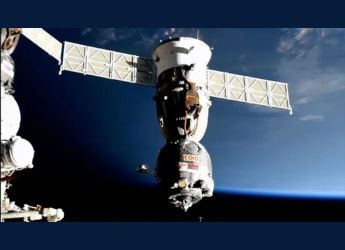- Home
- Science
- Science News
- NASA's Voyager 1 Space Probe Detects 'Persistent Hum' 14 Billion Miles From Earth
NASA's Voyager 1 Space Probe Detects 'Persistent Hum' 14 Billion Miles From Earth
The sound picked up by NASA could be a result of oscillating plasma waves.

Photo Credit: NASA/JPL-Caltech
NASA's Voyager 1 is now traversing through the interstellar medium
NASA's Voyager 1 probe has picked up an uncanny humming sound coming from space. NASA launched the Voyager 1 space probe 44 years ago and today it is the most distant human-made object from Earth, after exiting our solar system nine years ago. Since then, it has been exploring the near-emptiness of interstellar space and sending back valuable data to help us understand the world outside our solar system. Scientists now say instruments aboard the distant spacecraft have detected a “persistent hum” generated by the constant vibration of small amounts of gas in interstellar space. According to research published in the journal Nature Astronomy, this persistent monotonous humming is the sound of plasma waves oscillating and it is very weak.
A Cornell University-led team is studying the data sent by Voyager 1 from 14 billion miles away. Stella Koch Ocker, a doctoral student at Cornell University in New York, and one of the authors of the research, said the sound was very faint and monotone because it is in a narrow frequency bandwidth.You can listen to the sound here.
The Voyager 1 spacecraft flew by Jupiter in 1979, and the next year by Saturn, before crossing the heliopause — the solar system's border with interstellar space — in August 2012. It has now reached the interstellar medium.
Previously, too, after crossing the heliopause, Voyager 1's Plasma Wave System detected oscillations in the gas, but those were caused by our Sun.
“The interstellar medium is like a quiet or gentle rain,” said senior author of the study James Cordes in a statement on Cornell University's website.
Researchers now believe that there is more activity going on in the interstellar gas than previously thought. Voyager-1's data can help scientists understand the interactions between the interstellar medium and the sun's solar wind, a steady stream of charged particles.
Cornell research scientist Shami Chatterjee explained why continuous tracking of the interstellar space is important, saying scientists never had an opportunity to evaluate interstellar plasma but they do now as the Voyager 1 is flying through them and sending back data.
For the latest tech news and reviews, follow Gadgets 360 on X, Facebook, WhatsApp, Threads and Google News. For the latest videos on gadgets and tech, subscribe to our YouTube channel. If you want to know everything about top influencers, follow our in-house Who'sThat360 on Instagram and YouTube.
Related Stories
- Samsung Galaxy Unpacked 2025
- ChatGPT
- Redmi Note 14 Pro+
- iPhone 16
- Apple Vision Pro
- Oneplus 12
- OnePlus Nord CE 3 Lite 5G
- iPhone 13
- Xiaomi 14 Pro
- Oppo Find N3
- Tecno Spark Go (2023)
- Realme V30
- Best Phones Under 25000
- Samsung Galaxy S24 Series
- Cryptocurrency
- iQoo 12
- Samsung Galaxy S24 Ultra
- Giottus
- Samsung Galaxy Z Flip 5
- Apple 'Scary Fast'
- Housefull 5
- GoPro Hero 12 Black Review
- Invincible Season 2
- JioGlass
- HD Ready TV
- Laptop Under 50000
- Smartwatch Under 10000
- Latest Mobile Phones
- Compare Phones
- Motorola Edge 60
- Motorola Edge 60 Pro
- Motorola Razr 60
- Motorola Razr 60 Ultra
- Realme 14T 5G
- Redmi Turbo 4 Pro
- Honor X70i
- Red Magic 10 Air
- HP EliteBook 6 G1a
- HP EliteBook 8 G1a
- Honor Pad GT
- Vivo Pad SE
- Moto Watch Fit
- Honor Band 10
- Xiaomi X Pro QLED 2025 (43-Inch)
- Xiaomi X Pro QLED 2025 (55-Inch)
- Asus ROG Ally
- Nintendo Switch Lite
- Toshiba 1.8 Ton 5 Star Inverter Split AC (RAS-24TKCV5G-INZ / RAS-24TACV5G-INZ)
- Toshiba 1.5 Ton 5 Star Inverter Split AC (RAS-18PKCV2G-IN / RAS-18PACV2G-IN)

















